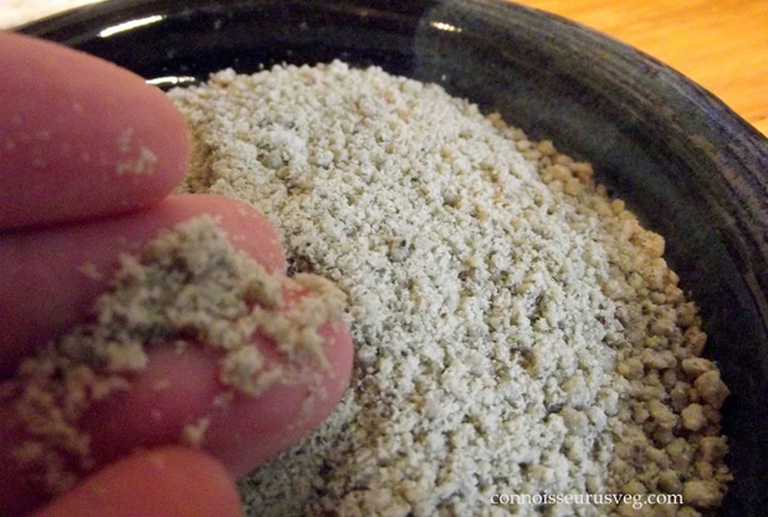
Factory farming conditions and antibiotic-resistant pathogens emerging as a result of them pose an existential threat to humans in the form of zoonotic diseases. Why it’s time to produce and consume food more thoughtfully.
A recipe that includes a healthy, tasty and sustainable ingredient: hemp.
500 g of hemp flour
230 g of water
1 piece of burrata cheese
150 ml of fresh cream
40 g of bread crumbs
25 g of Cantabrian anchovies
25 g of sun-dried tomatoes
50 gr of confit cherry tomatoes
1 shallot
10 g of fresh marjoram
2 g of Cyprus salt
2 organic lemons
dried fruits (pine nuts, pistachios, goji berries and raisins)

To prepare hemp pici, put the hemp flour in a bowl; form a well with it and gently pour the water at room temperature. Knead until smooth and with a silky texture, allow to rest for at least 30 minutes at room temperature, then spread out the dough and create a spaghetti-like shape by massaging the dough in your hands.
At this point, prepare the dried fruits (pine nuts, pistachios, gojy berries and raisins) by soaking them in sweet wine for a few minutes). Cut the sun-dried tomatoes, anchovies and shallot into julienne strips and cook them beginning from the latter. Take the burrata cheese and fresh cream and blend them until smooth. Toast the breadcrumbs in extra virgin olive oil, garlic and fresh chili pepper. Put little oil in a pan, add the minced shallot and simmer. Remove from heat and then add all other ingredients.
Cook the pasta for 4 minutes, drain and put in the pan with the other ingredients. Cook for two minutes, then add Tuscan extra virgin olive oil and a few fresh marjoram leaves and cook until creamy.
Dish out the hemp pici by pouring a spoonful of burrata cheese into a plate, laying a pasta nest on this and sprinkling with a spoonful of bread crumbs. Finally, grate little lemon peel and a few grain of Cyprus salt.
Siamo anche su WhatsApp. Segui il canale ufficiale LifeGate per restare aggiornata, aggiornato sulle ultime notizie e sulle nostre attività.
![]()
Quest'opera è distribuita con Licenza Creative Commons Attribuzione - Non commerciale - Non opere derivate 4.0 Internazionale.
Factory farming conditions and antibiotic-resistant pathogens emerging as a result of them pose an existential threat to humans in the form of zoonotic diseases. Why it’s time to produce and consume food more thoughtfully.
The world of cinema recognises the link between food choices and the climate crisis by offering vegan menus for awards season events, including at the most important of them all: the Oscars.
Let’s look at the reasons behind the growth of veganism in India, as a small yet vocal section of the population turns towards this diet and lifestyle in the largest milk producing country in the world.
by Jeffrey Y. Campbell, Manager of the Forest and Farm Facility at FAO In the Ecuadorian Amazon, Kichwa farmers grow dozens of products on tiny parcels of land. Their lands hum with biodiversity, yielding nutritious foods that have sustained families for generations. Wandering among fruit and nut trees and crops, these indigenous agroforesters fill their baskets
Mint has many health benefits, but in food it’s often accompanied by artificial green colourings. Instead, Galatea has created a green mint ice cream in a completely natural way.
We’re talking about Galatea, a company that produces semi-finished products for artisanal ice creams using high quality ingredients, natural colouring, excluding thickeners and hydrogenated fats, respecting the environment and supporting the less fortunate.
The mad rush to fake food, like fake meat made with genetically-modified soy, ignores the importance of the diversity of our foods and culinary cultures. It’s a recipe to accelerate the destruction of the Planet and our health.
Like with all foods, the quality of an ice cream can be discerned by reading its label. An expert explains how to do this, and tells us how their company steers clear of chemicals, using only natural ingredients to produce an excellent and “free” ice cream.
Quality ingredients, no artificial colouring and hydrogenated fats. These are the main features of a great ice cream. But what makes an ice cream parlour “good”, i.e. sustainable?







